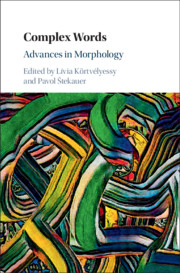Book contents
- Complex Words
- Complex Words
- Copyright page
- Dedication
- Contents
- Contributors
- Introduction: Advances in Morphology
- Part I Lexico-Semantic Aspects of Complex Words
- Part II Structure of Complex Words
- Part III Corpus-Based Case Studies
- 13 Competition between Synthetic NN Compounds and NN.gen Phrasal Nouns in Polish
- 14 An S Is an ’S, or Is It? Plural and Genitive Plural Are Not Homophonous
- 15 The Role of Word-Formation Families and Subfamilies in the Organization of German Diminutive Compounds
- 16 Semantic Patterns in Noun-to-Verb Conversion in English
- 17 Onomatopoeia
- 18 Dingsbums and Thingy
- Index
- References
15 - The Role of Word-Formation Families and Subfamilies in the Organization of German Diminutive Compounds
from Part III - Corpus-Based Case Studies
Published online by Cambridge University Press: 18 September 2020
- Complex Words
- Complex Words
- Copyright page
- Dedication
- Contents
- Contributors
- Introduction: Advances in Morphology
- Part I Lexico-Semantic Aspects of Complex Words
- Part II Structure of Complex Words
- Part III Corpus-Based Case Studies
- 13 Competition between Synthetic NN Compounds and NN.gen Phrasal Nouns in Polish
- 14 An S Is an ’S, or Is It? Plural and Genitive Plural Are Not Homophonous
- 15 The Role of Word-Formation Families and Subfamilies in the Organization of German Diminutive Compounds
- 16 Semantic Patterns in Noun-to-Verb Conversion in English
- 17 Onomatopoeia
- 18 Dingsbums and Thingy
- Index
- References
Summary
Not only formal word families are important for the organization of the morphologically complex lexicon, but also their semantic (or rather conceptual) subfamilies. This is shown with eighteen Austrian German diminutive compound families with the diminutive suffix -chen, and for their correspondent formal word families with the diminutive suffix -erl. For all of them, their competition (leading to mutual avoidances and semantic specializations), degree of morphosemantic transparency/opacity, productivity and left- vs. right-branching are accounted for. Our electronic database consists of nearly 13,000 different diminutive types which have at least five tokens within the Austrian Media Corpus.
Keywords
- Type
- Chapter
- Information
- Complex WordsAdvances in Morphology, pp. 293 - 310Publisher: Cambridge University PressPrint publication year: 2020

